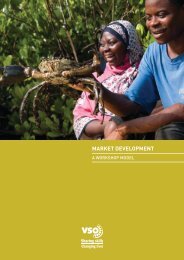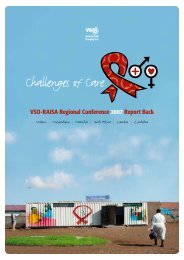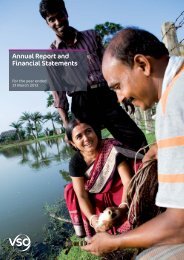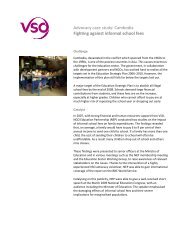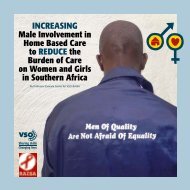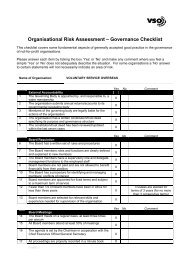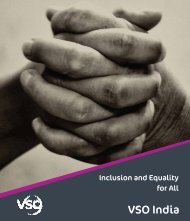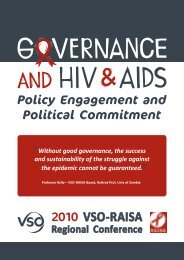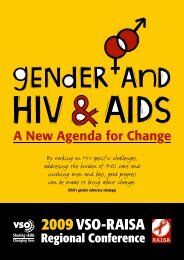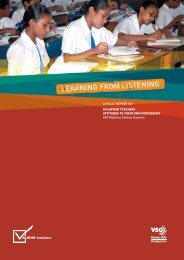Walking the Talk - VSO
Walking the Talk - VSO
Walking the Talk - VSO
You also want an ePaper? Increase the reach of your titles
YUMPU automatically turns print PDFs into web optimized ePapers that Google loves.
after <strong>the</strong>ir pregnancy. 124 Even <strong>the</strong> term ‘mo<strong>the</strong>r-to-child’risks labelling women as <strong>the</strong> main bearers of <strong>the</strong>disease to <strong>the</strong>ir offspring. Some organisations andservice providers have thus chosen to use <strong>the</strong> term‘parent-to-child’ transmission interventions (PPTCT)which acknowledges responsibilities of both parents.In response to <strong>the</strong>se issues, new kinds of interventionsare also being scaled up. Prevention of mo<strong>the</strong>r-to-childtransmission-Plus (PMTCT-Plus), with <strong>the</strong> ‘plus’representing treatment for women and o<strong>the</strong>r familymembers living with HIV and AIDS, represents importantprogress in this field. Not only do PPTCT or PMTCT-Plusprogrammes offer a more holistic set of services forpregnant women living with HIV and AIDS, providingpreventative <strong>the</strong>rapy, treatment and care for women in<strong>the</strong>ir own right (including treatment options beyondpregnancy), <strong>the</strong>y encourage <strong>the</strong> participation of men at allstages of pregnancy, delivery and care. This is ofparticular importance because, as we have notedthroughout this report, threats of violence or fear ofpartner desertion are significant obstacles to women’stesting, treatment, care and support. For example, aspart of a PMTCT-Plus programme in Côte d’Ivoire, trainedcounsellors not only help prepare for disclosure, butmitigate possible adverse consequences followingpartner notification of <strong>the</strong> woman’s HIV status. Servicesinclude counselling to sero-discordant couples to avoidblame and help <strong>the</strong>m to make risk reduction planstoge<strong>the</strong>r, as well as referrals to support services forwomen experiencing abuse, violence or abandonment. 125Such comprehensive programmes must be scaled upsignificantly. Globally, fewer than 20% of pregnantwomen and girls living with HIV and AIDS receivePMTCT, 126 leaving many women and girls unable toprevent <strong>the</strong>ir children’s infection. Moreover most womenreceiving PMTCT are still not receiving confidential pretestcounselling services that could protect <strong>the</strong>ir right toinformed consent. 127 A considerable number of womenin high-prevalence countries still do not know that HIVand AIDS can be passed from mo<strong>the</strong>r to child,exposing <strong>the</strong> way in which knowledge is still not widelyavailable to everyone – in particular women – makingcounselling efforts more difficult and violating women’srights to information and health. 1283.4. Services: voluntary counselling and testingVoluntary counselling and testing (VCT) is <strong>the</strong> gateway totreatment, care and support services. If women and girlsare prevented from accessing counselling and testing,<strong>the</strong>y are, by implication, denied <strong>the</strong>ir right to treatment,care and support and indeed to sexual and reproductivehealth information (including on HIV prevention) (seeChapter 2 for more information). VCT services mustrespect women’s rights, in particular <strong>the</strong>ir right to privacy.However, this doesn’t always happen. For example, poorstaff training means that VCT is not always voluntary orconfidential. The growing trend towards provider-initiatedtesting and counselling (PITC) is of particular concern. Itis crucial that this is delivered in a rights-based manner,for example, by ensuring that informed consent is givenbefore a test is taken and that follow-up care, supportand treatment services are available and accessible to allwho are tested.Women and girls must also be given <strong>the</strong> information tomake an informed decision whe<strong>the</strong>r or not to take anHIV test. 129 They need to understand what <strong>the</strong> test is forand what <strong>the</strong> post-test implications and outcomesmight be. Antenatal care, for example, has often led to<strong>the</strong> violation of women and girls’ rights to privacy andinformed consent. 130 In some cases, it seems to bestandard medical practice to test for HIV withoutproperly informing or consulting <strong>the</strong> woman.If testing takes place without counselling and support,women are denied <strong>the</strong> psychosocial support <strong>the</strong>y areentitled to as part of <strong>the</strong>ir right to health (see Chapter 5).Testing must also be free of charge to enable manywomen and girls to access <strong>the</strong>se services andsubsequent treatment. Moreover, counselling has <strong>the</strong>potential to reduce stigma if it involves couples as wellas individuals, and is supported with more resources fortraining and group education. 131In order for VCT to have a strong rights-basedapproach, women must be consulted in <strong>the</strong>ircommunities by health policy makers and officials aboutwhat would make <strong>the</strong> services most accessible andacceptable to <strong>the</strong>m. Programmes should emphasise <strong>the</strong>importance of counselling and evidence-basedinformation to avoid stigma, and allow women to make<strong>the</strong> decision to have an HIV test. Moreover, policymakers and health officials need to find ways toencourage VCT without resorting to coercion. Thisrequires respect for women’s right to information andright to privacy.As this chapter has shown, HIV prevention for womenand girls must address <strong>the</strong>ir “inadequate knowledgeabout AIDS, insufficient access to HIV-preventionservices, inability to negotiate safer sex, and a lack offemale-controlled HIV prevention methods, such asmicrobicides.” 132 If HIV prevention activities are tosucceed <strong>the</strong>y must occur alongside o<strong>the</strong>r efforts, suchas legal reform, promotion of women’s rights,programmes to challenge gender inequalities andnorms, and socio-economic empowerment.28 <strong>Walking</strong> <strong>the</strong> talk putting women's rights at <strong>the</strong> heart of <strong>the</strong> HIV and AIDS response




